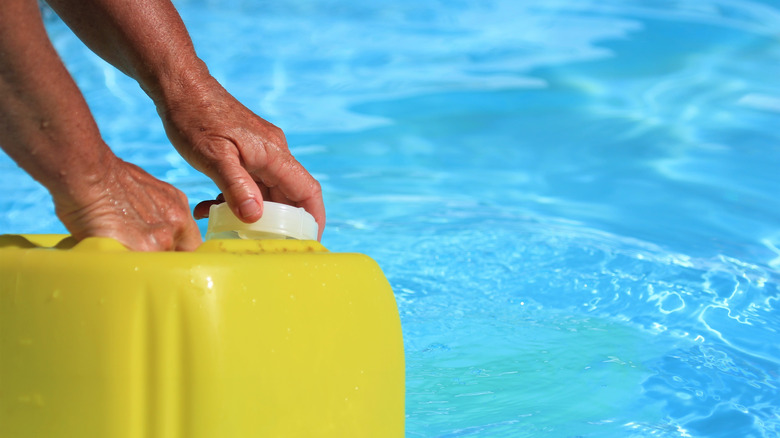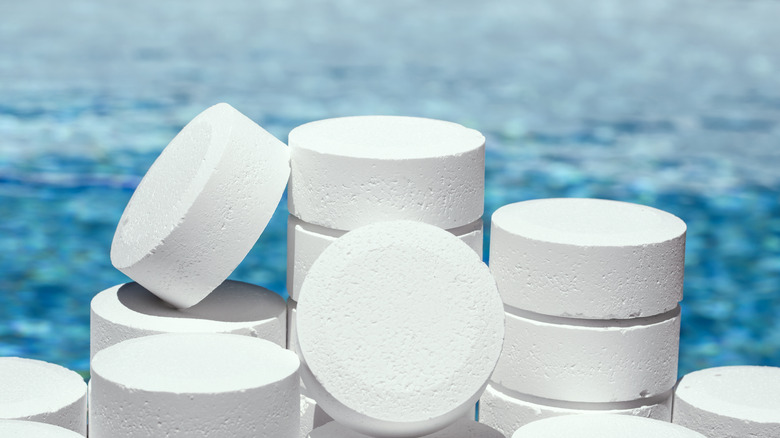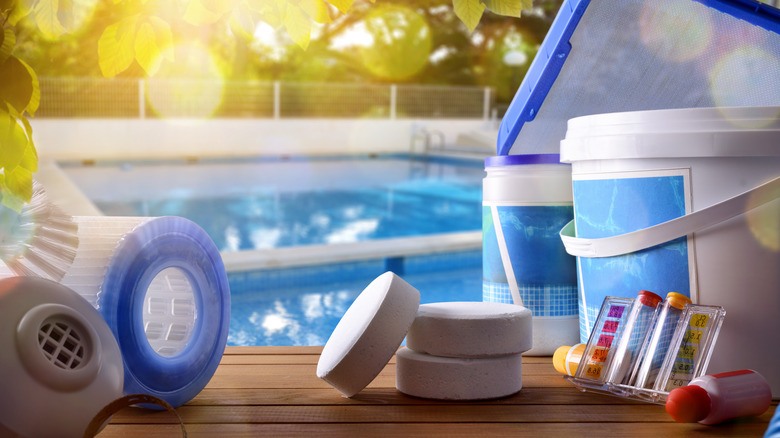What Does It Mean To Shock Your Swimming Pool?
Swimming pools are a feature of idyllic American life. Pool Research reports that there are nearly 11 million pools in the United States — one for every 33 people. As an immensely rewarding leisure installation, swimming pools provide hours of fun and relaxation to homeowners. They can also be built in a variety of configurations and with high-end amenities or basic infrastructure that maximizes water volume.
But life with a pool isn't without its added work. For one thing, covering your pool is worth the effort on a long-term basis. This will keep leaves, dirt, and other debris out of the water. Proper care is crucial to keeping algae growth to a minimum, reducing the incidence of bacteria, and insulating the pool's temperature against wild swings — especially during the winter months. Still, there is an additional measure that homeowners with pools have to take on a regular basis: shocking the pool.
Pool owners typically use chlorine to balance the pH levels in their aquatic environment. Arm & Hammer advises that a healthy pH sits between 7.4 and 7.6 (but a range between 7.2 and 7.8 is acceptable). A lower value makes the water acidic and can harm your eyes and even the equipment in the water. Water that's baser will allow bacteria to thrive and can affect your skin and overall health. It's a balancing act, but shocking your pool can help make this endeavor easier.
Why shock your pool
Shocking the pool is the process of adding an oxidizing agent to the water body (via In the Swim). Often, this oxidizer includes chlorine, but it doesn't necessarily have to. There is a wide range of options when it comes to pool shock, but they all provide a means to achieve the same end goal.
Pool shocking is done to rapidly change the level of chlorine (specifically free chlorine) in your pool. Forbes Home notes the difference between free chlorine and combined or total chlorine, noting that combined chlorine is that which is bound to contaminants while free chlorine is in the environment freely and able to eliminate contaminants by binding with them. Total chlorine is the sum total of both. Free chlorine is essential to maintaining a healthy pool, and a totally sanitary pool is one that has no measured combined chlorine. This suggests that no contaminants are present. Of course, this is an ideal circumstance, but regular pool shock usage can help you get closer to the goal.
Essentially, you'll add a shocking agent to raise the free chlorine level in the pool in an effort to eliminate oils and organic materials, kill bacteria and algae, and remove odorous and eye-irritating chloramines that form when chlorine binds with contaminants.
Types of shocking agents
There are three primary pool shock options on the market. They are calcium hypochlorite (cal-hypo), sodium dichlor, and potassium monopersulfate (chlorine-free shock), according to Leslie's Pool and In the Swim.
Cal-hypo is the most common shock that homeowners will use. It's cost-effective and functionally effective as well. These shocking agents include calcium as a part of the mix and come in 65% and 73% strength. This product doesn't include cyanuric acid, which may be found in a typical trichlor tablet that you already use to maintain healthy pH levels in the pool. However, if you're worried about calcium hardness in the water, dichlor is perhaps the better option as it doesn't contain calcium. The addition of cyanuric acid gives the chlorine formula better protection from the sun, meaning it will last longer in the pool's environment and take greater effect.
Both of these tools use chlorine as a primary means of resetting the pool's chlorinated ecosystem. However, you can use a non-chlorinated formula as well. These oxidizers won't add new chlorine, of course, but they improve the effectiveness of existing chlorine levels over time. This formula is also safe for swimmers in just 15 minutes, whereas you're likely to require a 24 to 48-hour wait to swim again after using a chlorinated shock formula. These are great for vinyl pools, too, because the harsh chlorine addition of the other types can effectively bleach the color from a vinyl liner.


